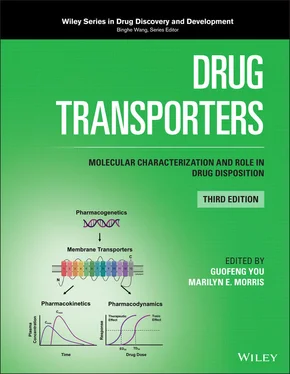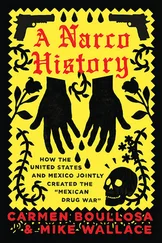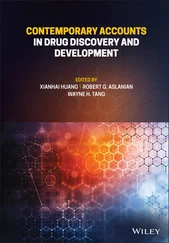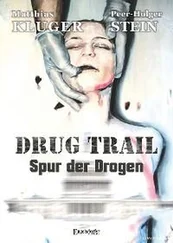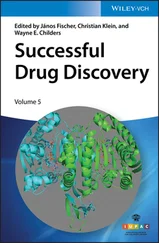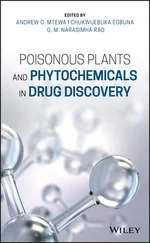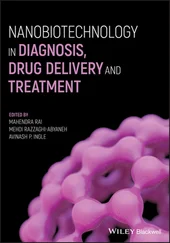Drug Transporters
Здесь есть возможность читать онлайн «Drug Transporters» — ознакомительный отрывок электронной книги совершенно бесплатно, а после прочтения отрывка купить полную версию. В некоторых случаях можно слушать аудио, скачать через торрент в формате fb2 и присутствует краткое содержание. Жанр: unrecognised, на английском языке. Описание произведения, (предисловие) а так же отзывы посетителей доступны на портале библиотеки ЛибКат.
- Название:Drug Transporters
- Автор:
- Жанр:
- Год:неизвестен
- ISBN:нет данных
- Рейтинг книги:4 / 5. Голосов: 1
-
Избранное:Добавить в избранное
- Отзывы:
-
Ваша оценка:
- 80
- 1
- 2
- 3
- 4
- 5
Drug Transporters: краткое содержание, описание и аннотация
Предлагаем к чтению аннотацию, описание, краткое содержание или предисловие (зависит от того, что написал сам автор книги «Drug Transporters»). Если вы не нашли необходимую информацию о книге — напишите в комментариях, мы постараемся отыскать её.
Drug Transporters: Molecular Characterization and Role in Drug Disposition
Drug Transporters: Molecular Characterization and Role in Drug Disposition, Third Edition
Drug Transporters — читать онлайн ознакомительный отрывок
Ниже представлен текст книги, разбитый по страницам. Система сохранения места последней прочитанной страницы, позволяет с удобством читать онлайн бесплатно книгу «Drug Transporters», без необходимости каждый раз заново искать на чём Вы остановились. Поставьте закладку, и сможете в любой момент перейти на страницу, на которой закончили чтение.
Интервал:
Закладка:
1.7 NOMENCLATURE OF DRUG TRANSPORTERS
The primary objective of this nomenclature is to provide a unifying system of assigning an unambiguous designation to each drug transporter gene and its protein, inclusive of the specific subclass to which it belongs. This book adopts the HUGO‐approved designations, which are used widely by the drug transporter communities. In general, the genes are named using the root symbol, e.g., SLC, followed by a numeral (e.g., SLC22, solute carrier family 22), followed by a letter that defines the subfamily (only A is used when the family has not been subdivided), and finally a number designating the individual transporter gene (e.g., SLC22A6). Transporters are assigned to a specific family if the encoded protein has at least 20% amino acid sequence identity to other members of that family. There is also naming difference between human and nonhuman species: For human gene, e.g., SLCO (all italicized, all capitalized), and for human protein, e.g., OATP (not italicized, all capitalized); For nonhuman gene, e.g., Slco (all italicized, only the initial letter is capitalized), and for nonhuman protein, e.g., Oatp (not italicized, only the initial letter is capitalized).
1.8 REGULATION OF DRUG TRANSPORTERS
Giving the importance of drug transporters in the absorption, distribution, and excretion of a diverse array of environmental toxins and clinically important drugs, alteration in the function of these transporters plays a critical role in intra‐ and inter‐individual variability of the therapeutic efficacy and the toxicity of the drugs. As a result, the activity of drug transporters must be under tight regulation so as to carry out their normal duties. Key players involved in the regulation of transporters are hormones, protein kinases, nuclear receptors, scaffolding proteins, and disease conditions. These players may affect transporter activity at multiple levels, including (i) when and how often a gene encoding a given transporter is transcribed (transcriptional control), (ii) how the primary RNA transcript is spliced or processed (RNA processing control), (iii) which mRNA in the cytoplasm is translated by ribosomes (translational control), (iv) which mRNA is destabilized in the cytoplasm (mRNA degradation control), and (v) how a transporter is modified and assembled after it has been made (posttranslational control). Post‐translational modification may alter physical and chemical properties of the transporters, their folding, conformation, distribution, stability, and their activity. Because of such loops and layers of regulation, the functional diversity of these transporters often far exceeds the considerable molecular diversity of the transporter genes, which may help in utilizing identical transporter proteins for different cellular functions in different cell types.
Regulation of transporter activity at the gene level usually occurs within hours and days and is therefore classified as long‐term or chronic regulation. Long‐term regulation usually occurs when the body undergoes massive change, such as during development or the occurrence of disease. Regulation at the posttranslational level usually occurs within minutes or hours and is therefore classified as short‐term or acute regulation. Short‐term regulation usually occurs when the body has to deal with rapidly changing amounts of substances as a consequence of variable intake of drugs, fluids, or meals, as well as metabolic activity.
The overlapping substrate specificities among different transporters or different isoforms of the same transporter, their wide tissue distributions, and the various types of regulation of expression and function, mediated by signaling molecules secreted from remote tissues into the body fluids, contribute to the complicated communication network. Hormones and growth factors produced and released from the original organ under the internal and external stimuli arrive at the target organ and regulate the transporters in the target organ. Such networks contribute to intercellular and inter‐organ communication. This communication between cells, as well as between organs, regulates local and whole‐body homeostasis of endogenous substrates.
1.9 CONCLUSION
As our readers have come to expect, the current and comprehensive information about the drug transporters is the major distinguishing feature of this book. The knowledge presented in this book will enrich our understanding on how pathological conditions, genetic variation, cellular signaling, aging, and drug–drug interactions impact transporter‐mediated drug disposition.
REFERENCES
1 [1] Koehler MR, Wissinger B, Gorboulev V, Koepsell H, Schmid M. The two human organic cation transporter genes SLC22A1 and SLC22A2 are located on chromosome 6q26. Cytogenet Cell Genet 1997; 79:198–200.
2 [2] Verhaagh S, Schweifer N, Barlow DP, Zwart R. Cloning of the mouse and human solute carrier 22a3 (Slc22a3/SLC22A3) identifies a conserved cluster of three organic cation transporters on mouse chromosome 17 and human 6q26‐q27. Genomics 1999; 55:209–218.
3 [3] Peltekova VD, Wintle RF, Rubin LA, Amos CI, Huang Q, Gu X, Newman B, Van Oene M, Cescon D, Greenberg G, Griffiths AM, St George‐Hyslop PH, Siminovitch KA. Functional variants of OCTN cation transporter genes are associated with Crohn disease. Nature Genet 2004; 36:471–475.
4 [4] Shoji Y, Koizumi A, Kayo T, Ohata, T, Takahashi T, Harada K, Takada G. Evidence for linkage of human primary systemic carnitine deficiency with D5S436: a novel gene locus on chromosome 5q. Am J Hum Genet 1998; 63:101–108.
5 [5] Lamhonwah AM, Skaug J, Scherer SW, Tein I. A third human carnitine/organic cation transporter (OCTN3) as a candidate for the 5q31 Crohn's disease locus (IBD5). Biochem Biophys Res Commun 2003; 301 (1):98–101.
6 [6] Eraly SA, Nigam SK. Novel human cDNAs homologous to Drosophila Orct and mammalian carnitine transporters. Biochem Biophys Res Commun 2002; 297 (5):1159–66. doi: 10.1016/s0006‐291x(02)02343‐4. PMID: 12372408.
7 [7] Enomoto A, Wempe MF, Tsuchida H, Shin HJ, Cha SH, Anzai N, Goto A, Sakamoto A, Niwa T, Kanai Y, Anders MW, Endou H. Molecular identification of a novel carnitine transporter specific to human testis: insights into the mechanism of carnitine recognition. J Biol Chem 2002; 277:36262–36271.
8 [8] Bahn A, Prawitt D, Buttler D, Reid G, Enklaar T, Wolff NA, Ebbinghaus C, Hillemann A, Schulten HJ, Gunawan B, Fuzesi L, Zabel B, Burckhardt G. Genomic structure and in vivo expression of the human organic anion transporter 1 (hOAT1) gene. Biochem Biophys Res Commun 2000; 275:623–630.
9 [9] Kok LD, Siu SS, Fung KP, Tsui SK, Lee CY, Waye MM. Assignment of liver‐specific organic anion transporter (SLC22A7) to human chromosome 6 bands p21.2‐p21.1 using radiation hybrids. Cytogenet Cell Genet 2000; 88:76–77.
10 [10] Race JE, Grassl SM, Williams WJ, Holtzman EJ. Molecular cloning and characterization of two novel human renal organic anion transporters (hOAT1 and hOAT3). Biochem Biophys Res Commun 1999; 255 (2):508–514.
11 [11] Enomoto A, Kimura H, Chairoungdua A, Shigeta Y, Jutabha P, Cha SH, Hosoyamada M, Takeda M, Sekine T, Igarashi T, Matsuo H, Kikuchi Y, Oda T, Ichida K, Hosoya T, Shimokata K, Niwa T, Kanai Y, Endou H. Molecular identification of a renal urate‐anion exchanger that regulates blood urate levels. Nature 2002; 417:447–452.
12 [12] Klein K, Jüngst C, Mwinyi J, Stieger B, Krempler F, Patsch W, Eloranta JJ, Kullak‐Ublick GA. The human organic anion transporter genes OAT5 and OAT7 are transactivated by hepatocyte nuclear factor‐1α (HNF‐1α). Mol Pharmacol 2010; 78 (6):1079–1087.
13 [13] Li TT, An JX, Xu JY, Tuo BG. Overview of organic anion transporters and organic anion transporter polypeptides and their roles in the liver. World J Clin Cases 2019; 7 (23):3915–3933.
Читать дальшеИнтервал:
Закладка:
Похожие книги на «Drug Transporters»
Представляем Вашему вниманию похожие книги на «Drug Transporters» списком для выбора. Мы отобрали схожую по названию и смыслу литературу в надежде предоставить читателям больше вариантов отыскать новые, интересные, ещё непрочитанные произведения.
Обсуждение, отзывы о книге «Drug Transporters» и просто собственные мнения читателей. Оставьте ваши комментарии, напишите, что Вы думаете о произведении, его смысле или главных героях. Укажите что конкретно понравилось, а что нет, и почему Вы так считаете.
